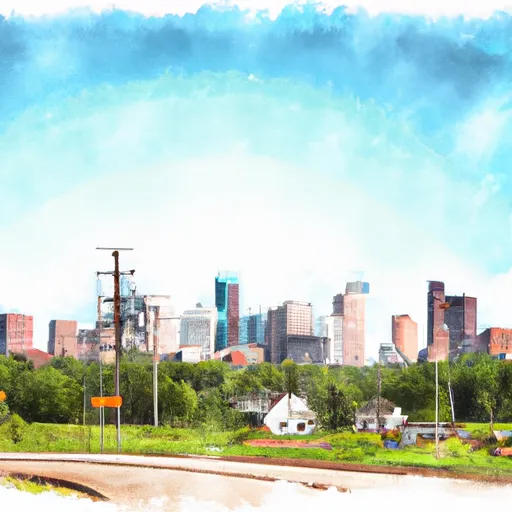-
 Snoflo Premium
Snoflo Premium
Get unlimited access to all our content
With no Ad interruptions! - Start Your Free Trial Login with existing account
Houston
Eden Index
Climate
6.7
•
Recreation
1.4
•
Community
3.2
•
Safeguard
3.9/10

Houston, Minnesota is a charming small town located in the southeastern part of the state. It experiences a humid continental climate with warm summers and cold winters. Summers are pleasant, with average temperatures ranging from 70°F to 80°F, perfect for outdoor activities. Winters, on the other hand, can be cold, with temperatures ranging from 20°F to 30°F, offering opportunities for winter sports and activities.
Houston is blessed with abundant water resources, being situated near the Root River. This river not only adds to the picturesque beauty of the town but also provides opportunities for various hydrology constituents. Anglers can enjoy fishing for trout, bass, and catfish, while kayakers and canoers can explore the scenic waterways. The Root River State Trail is a popular attraction, offering biking and hiking opportunities along its banks.
Outdoor enthusiasts will find numerous recreational activities to enjoy in Houston. The town is surrounded by stunning natural areas and parks, including the nearby Houston Nature Center. Visitors can hike the trails, observe wildlife, and learn about the local ecosystem. Other activities include camping, birdwatching, hunting, and cross-country skiing in the winter months.
Overall, Houston, Minnesota offers a delightful climate, abundant water resources, and diverse outdoor recreation opportunities, making it an ideal destination for nature lovers and outdoor enthusiasts.
What is the Eden Index?
The Snoflo Eden Index serves as a comprehensive rating system for regions, evaluating their desirability through a holistic assessment of climate health, outdoor recreation opportunities, and natural disaster risk, acknowledging the profound impact of these factors on livability and well-being.
Climate Health Indicator (CHI): 6.7
Houston receives approximately
877mm of rain per year,
with humidity levels near 82%
and air temperatures averaging around
8°C.
Houston has a plant hardyness factor of
4, meaning
plants and agriculture in this region thrive during a short period during spring and early summer. Most
plants will die off during the colder winter months.
By considering the ideal temperature range, reliable water supplies, clean air, and stable seasonal rain or snowpacks, the Climate Health Indicator (CHI) underscores the significance of a healthy climate as the foundation for quality living.
A healthy climate is paramount for ensuring a high quality of life and livability in a region, fostering both physical well-being and environmental harmony. This can be characterized by ideal temperatures, reliable access to water supplies, clean air, and consistent seasonal rain or snowpacks.
Weather Forecast
Streamflow Conditions
Upper Mississippi-Black-Root
Area Rivers
Upper Mississippi-Black-Root
Snowpack Depths
Upper Mississippi-Black-Root
Reservoir Storage Capacity
Upper Mississippi-Black-Root
Groundwater Levels
Recreational Opportunity Index (ROI): 1.4
The Recreational Opportunity Index (ROI) recognizes the value of outdoor recreational options, such as parks, hiking trails, camping sites, and fishing spots, while acknowledging that climate plays a pivotal role in ensuring the comfort and consistency of these experiences.
Access to outdoor recreational opportunities, encompassing activities such as parks, hiking, camping, and fishing, is crucial for overall well-being, and the climate plays a pivotal role in enabling and enhancing these experiences, ensuring that individuals can engage in nature-based activities comfortably and consistently.
Camping Areas
| Campground | Campsites | Reservations | Toilets | Showers | Elevation |
|---|---|---|---|---|---|
| Ray Behrens | None | 677 ft | |||
| Pulltite - Ozark National Scenic River | 55 | 817 ft | |||
| Mark Twain State Park | None | 666 ft | |||
| Hermann City RV Park | 20 | 509 ft | |||
| Akers | None | 818 ft | |||
| Montauk State Park | None | 910 ft | |||
| Alley Spring - Ozark National Scenic River | 162 | 672 ft | |||
| Chamois Access - MDC | 4 | 530 ft | |||
| Graham Cave State Park | None | 778 ft | |||
| Round Spring - Ozark National Scenic River | None | 673 ft |
Nearby Ski Areas
Catastrophe Safeguard Index (CSI):
The Catastrophe Safeguard Index (CSI) recognizes that natural disaster risk, encompassing floods, fires, hurricanes, and tornadoes, can drastically affect safety and the overall appeal of an area.
The level of natural disaster risk in a region significantly affects safety and the overall livability, with climate change amplifying these risks by potentially increasing the frequency and intensity of events like floods, fires, hurricanes, and tornadoes, thereby posing substantial challenges to community resilience and well-being.
Community Resilience Indicator (CRI): 3.2
The Community Resilience Indicator (CRI) recognizes that education, healthcare, and socioeconomics are crucial to the well-being of a region. The CRI acknowledges the profound impact of these elements on residents' overall quality of life. By evaluating educational resources, healthcare accessibility, and economic inclusivity, the index captures the essential aspects that contribute to a thriving community, fostering resident satisfaction, equity, and social cohesion.

